Movie Review By: Metatron
Year: 1998
Directed by: Rob Bowman
Written by: William Gibson & Tom Maddox
IMDB Reference
Degree of Cyberpunk Visuals: Medium
Correlation to Cyberpunk Themes: Very High
Key Cast Members:
Esther Nairn/Invisigoth: Kristin Lehman
Fox Mulder: David Duchovny
Dana Scully: Gillian Anderson
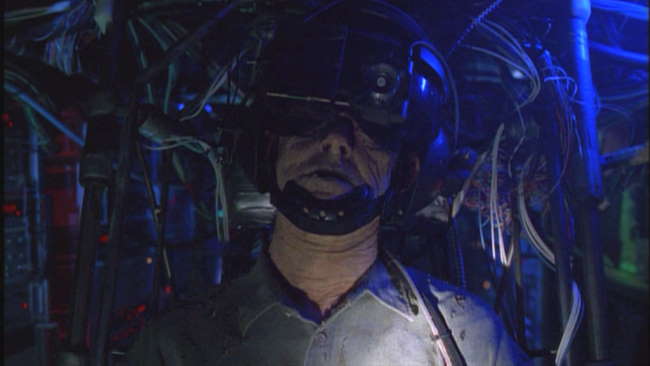
This is what happens when you forget there IS a real world outside…
Overview: Now, surely there must have been some kind of mistake. This is Cyberpunk Review, right? OK. Since when stories of little green men do qualify as such? Surely the mere fact that agent Scully had an implant in her neck does not count for an awful lot.
All true. This particular episode, however, is different. Look at the credits. William Gibson. Ring any bells?
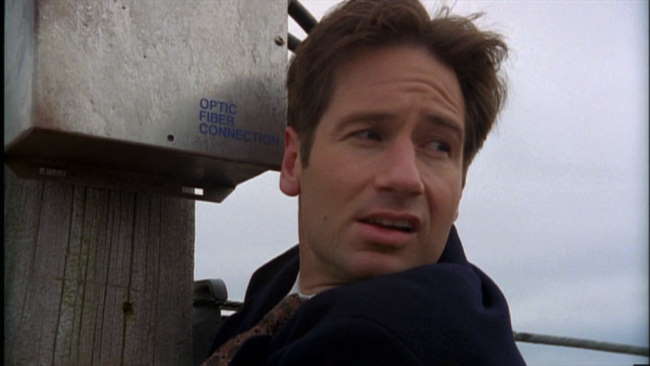
More Than Meets the Eye: It all starts with a rather innocuous shootout at a diner in a drab neighbourhood. Piece of cake, eh? Well, not exactly, as it turns out that one of the victims is in fact a top IT expert and programmer whose death might have been anything less than a coincidence. Soon afterwards Mulder and Scully happen upon a rather charming lady going by the nick-name of Invisigoth, who turns out to be much more than just a leather-clad Trinity wannabe…
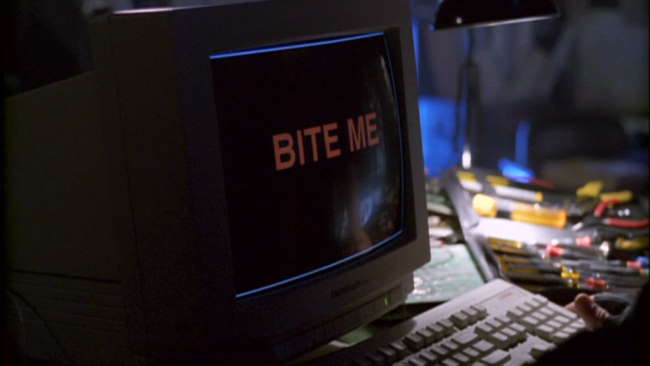
The threat, it is revealed, comes from a fugitive AI she and her companions helped to spawn. This synthetic entity seems to have little regard for human life, plus it possesses some rather eccentric habits, such as playing with leftover Star Wars military orbital lasers and residing in abandoned… camping trailers. Needless to say it has to be stopped, although it may yet turn out Invisigoth pursues a different agenda altogether…
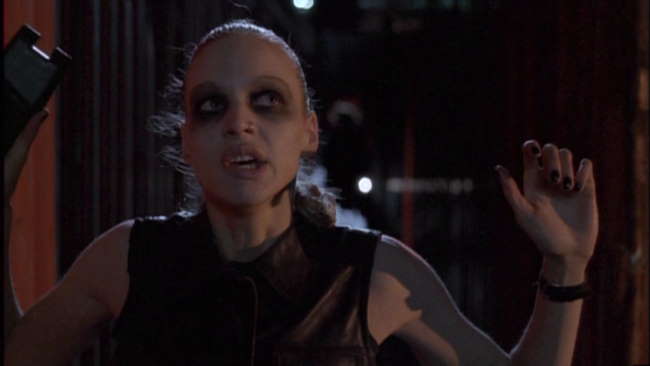
“Okay mom, I did actually use your eye-liner…”
Out There: Even if the credits said “Jay Leno” or “Kermit the Frog” rather than Gibson, there still would be a good case to make for the overall cyberpunk feel of this standalone episode. In terms of themes, it is all there- the pursuit of the AI takes place both in our very own “desert of the real” and through the net; agent Mulder even gets to become a multiple amputee courtesy of the malicious program’s VR simulation. More interestingly, the episode deals with the transfer of consciousness- translating a human psyche into digital data in pursuit of a peculiar kind of disembodied immortality. It is at that point one may begin to realise that one of the foremost attractions of the concept of sentient cyberspace entities is that cyberspace begins, to the mind of many, resemble a manufactured heaven of sort, a synthetic paradise for the unbelievers, allowing those of little religious zeal to dream of achieving transcendence. This move to another plane of existence, an ersatz afterlife- may not be explored at lengths here, yet gives a good cause for reflection. Apart from the sentient computer theme there is of course our sweet little Trinity impersonator (prettier than the real deal? I might be getting controversial here…) who also happens to drive a car (1960s Imperial, to be exact) very similar to the black Lincoln in the first Matrix.
Convinced? And then you realise that this episode actually comes from 1998, which is a year BEFORE tha Matrix… So, who’s the copycat, eh Trinity? Guess I should be expecting a lawsuit for these allegations any time now…
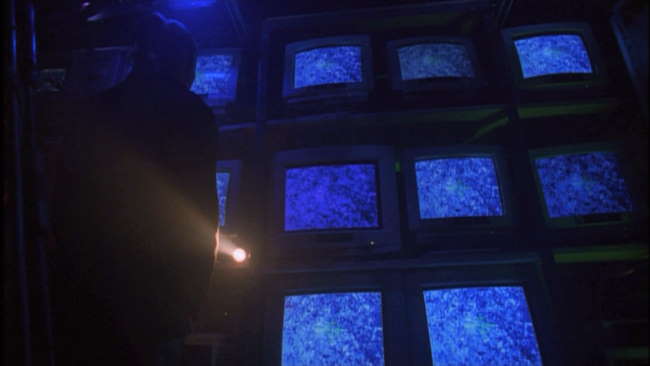
The Visuals: While not trying to rival Blade Runner, the visuals are decent for the budget. Being that this is an X-files episode, we shouldn’t expect anything too fancy - the series rarely relies on fancy visuals to generate their mood, or to depict story elements. One of the distinct traits of the X-Files is that they can often make ordinary places or events appear menacing and sinister when placed in the given context - this applies to Kill Switch.
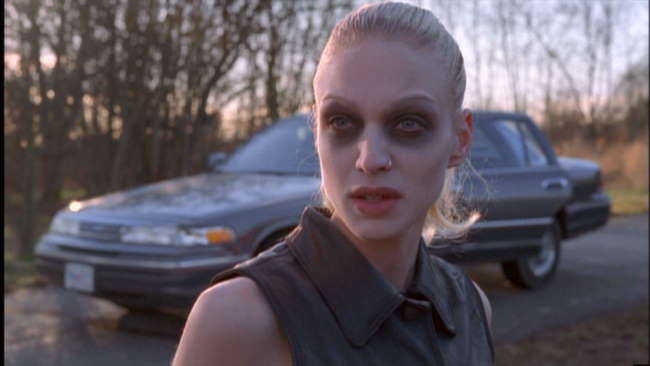
I assure you that, having seen this episode, the next time you’ll see a decaying camping trailer you’re gonna think twice before approaching it. In a way this depiction of cyberpunk is more realistic - inconspicuous locations concealing the drama of furtive technological experiments and computer crime is very much what one’s bound to encounter today. The most important bit - the flow of data - is hidden from the eye. The episode does treat us to some juicy cyberpunk visual elements, including gloomy improvised computer labs, and chaotic nests of cables and wires lit by the dim glow of terminal screens - but nothing too extravagant (aside for a few explosions).
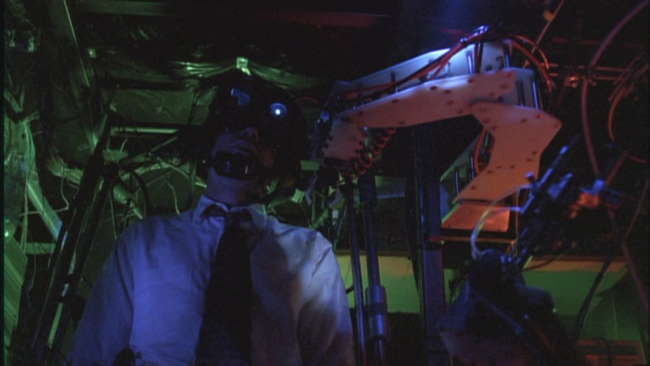
Confirm File Delete: Overall the episode represents a truly interesting foray of the famous franchise into the realms of cyberpunk, courtesy of Mr. Gibson himself. As with many other episodes, the strength of Kill Switch lies in its inherently believable narration, a mixture of the ordinary and the imaginary that made the series famous. The acting is decent- Invisigoth oozes character- and the action tightly coiled into a mere 45 minutes of film. Yet because of the unspectacular nature of the whole thing few will probably have seen and noticed it, even if this is as close as we can get into having a Gibson story made into a feature film, after his Alien3 script got binned long ago. It may not be cyberpunk canon in any way, but do watch it- I swear that after those 45 minutes you’re likely to be craving for more. Which you just might get, as there is another Gibson-written X-File which I will investigate soon…
~See movies similar to this one~
Tags: TV episode review
Year: 1984
Directed by: James Cameron
Written by: James Cameron, Gale Anne Hurd
IMDB Reference
Degree of Cyberpunk Visuals: High
Correlation to Cyberpunk Themes: Very High
Key Cast Members:
The Terminator: Arnold Schwarzenegger
Kyle Reese: Michael Biehn
Sarah Connor: Linda Hamilton
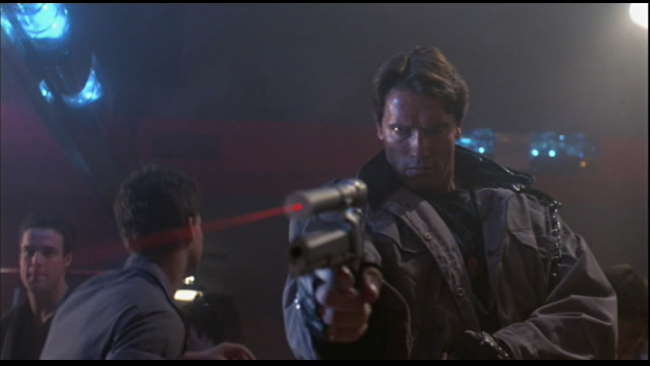
“The Terminator’s an infliltration unit…part man - part machine. Underneath it’s a hyper-alloy combat chassey…microprocessor controled…fully armored - Very tough. But outside its living human tissue…flesh…skin…hair…blood - grown for the cyborgs.”
Overview: No movie has been more imitated in cyberpunk than the Terminator. While most of the imitations have been grade “B” shlock films, they attest to the intense effect that the Terminator had on our consciousness. This film is legendary, and easily ranks in the top 5 or 6 most influential cyberpunk films ever created (Blade Runner, Metropolis, Ghost in the Shell, and The Matrix being the other four, and Alien if you consider that cyberpunk). Terminator is a film with terrific replay value – so much so that I’m guessing all of you have seen it enough times that I don’t need to bore you with a plot overview. With a 6.4 million dollar production budget, this is far from a big-budget blockbuster. The reason it’s stood the test of time, and in fact comes across as a block buster, comes down to incredible execution by beginning film maker James Cameron and cast.
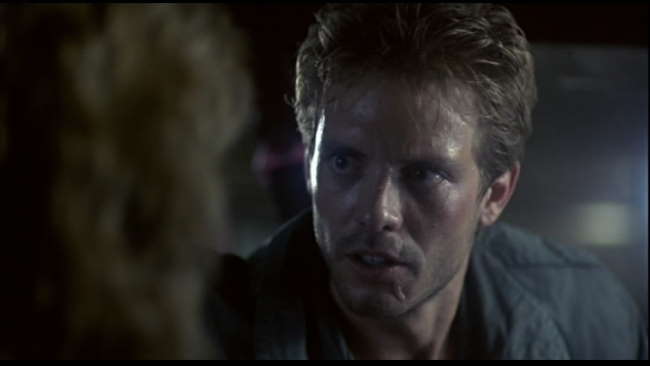
“I’m here to help you…I’m Reece - Sargeant Tech Com BN38416 - assigned to protect you…You’ve been targeted for termination.”
The Acting: From Schwarzenegger’s eery style of acting, to Linda Hamilton’s growth on screen from a shy teen to tough mother of mankind, to Michael Biehn’s tour-de-force performance from beginning to end, the leads flat out carry this movie. That said, the background characters are all terrific, including Bill Paxton at the beginning (“Fuck you, asshole!”), to Paul Winfield (Lieutenant Traxlet), Lance Henriksen (Detective Vukovich) and psychologist, Earl Boen. There are too many memorable scenes to relate here, but the real strength of the acting in this case comes more in expressions and setting mood than it does in delivering the lines, although Beihn’s narrative in particular is riviting.
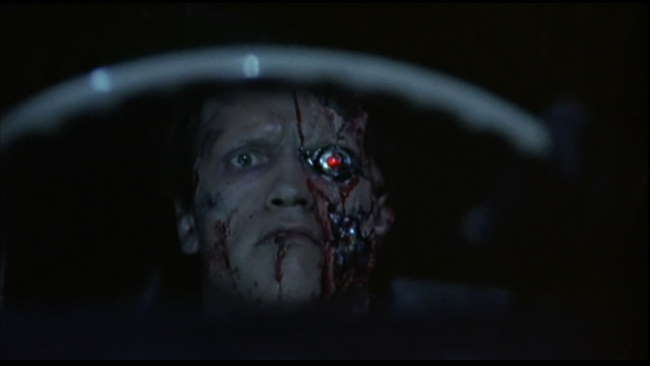
The 600 series had rubber skin. We spotted them easy. But these are new…they look human. Sweat…bad breath…everything…very hard to spot.
Reece’s character does straight exposition to explain the story, which is usually a lousy delivery method. However, the mix of action and exposition just works. The dialogue was terrific, and Reece delivered it in the context of a high-tension chase. During this, Hamilton’s character literally transforms from a vulnerable, girl-next-door to a hard-edged, do-what’s-necessary, take charge kind of gritty leader. Their chemistry is terrific. They have a shy tension, that eventually turns into an intense, believable love affair. It’s kind of amazing that the studio originally wanted Arnold Schwarzenegger to play Reece. Schwarzenegger as the Terminator provides us one of the all time characters in all of scifi. He is the ultimate warrior android, and has been imitated far too many times to count.
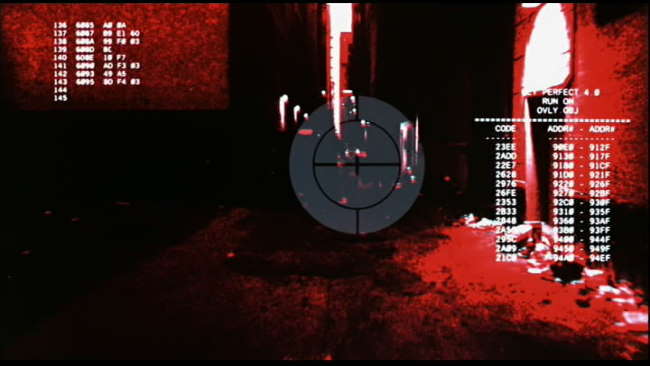
“There was a nuclear war…about a few years from now…all this….this whole place…its gone…just gone… the survivors…here…there…nobody knew how it started…it was the machines, Sarah.”
The Pacing: The Terminator’s pacing is probably the most copied aspect of this film. The Terminator, from the very first scene to the very last is a chase movie. The tension goes from high to massively high to short breathers, back to massively high tension. You literally feel tired after watching this. While this doesn’t seem unusual now, back in the early 80s, The Terminator took the hectic fast pacing of Raiders of the Lost Ark and adapted it to a full scale chase flick. The real magic here was Cameron’s ability to embed a fascinating story into the chase, while changing the bad guy from human to robot to basically add a completely new feeling to the chase.
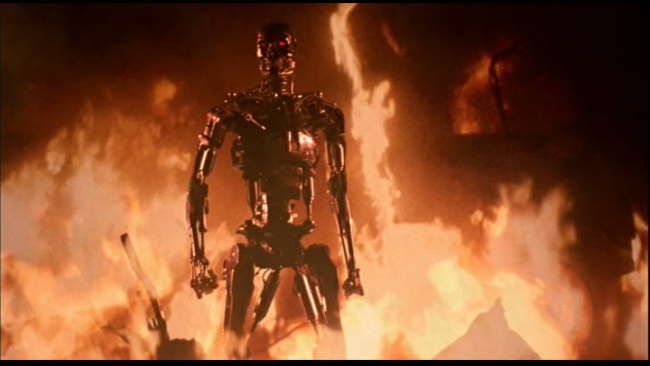
“You still don’t get it, do you…He’ll find her. That’s what he does! That’s ALL he does! You can’t stop him. He’s wade through you, reach down her throat and pull her fucking heart out!”
The FX: For the budget, Terminator’s FX far exceeded anything that should have been possible. The Endoskeleton, made up of miniatures, models and stop-motion animation, is now part of movie lore. The car chase scenes still look terrific, as do the explosions. The near-future dystopic scenes are completely riveting, especially the flying HKs! However, a few of the model shots of Arnold do look slightly dated now (most noticeably when Arnold takes out his eye).

“In the few hours we had together, we loved a lifetime’s worth.”
The Score: Brad Fiedel’s percussive, driving beat that creates an industrial masterpiece that absolutely nails the feeling of The Terminator. You can still here the “dun-dun dun dun-dun” beat and IMMEDIATELY get teleported back to that sense ominous doom of the future that the Terminator portends.
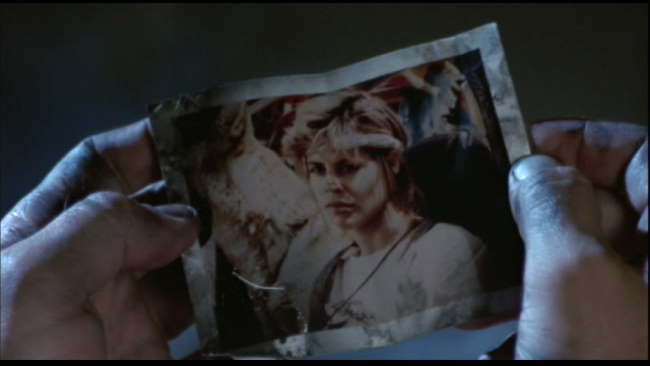
“That was a good hussle, kid.”
Time Travel: The Terminator provides us one of the best time travel movies in cinema. It’s intelligently done in a coherent way that really sets the picture moving. But the real majesty is in the photograph (see above). I LOVE the picture and everything it represents. There, in that one image, we get the entire love affair of Sarah and Reece, John’s struggle relating to someone he knows to be his father (but who cannot know in return), Sarah’s future journey, and a wonderful mind fuck to boot! The placement of the time travel elements at the beginning and ending of the story really do add impact to its meaning.
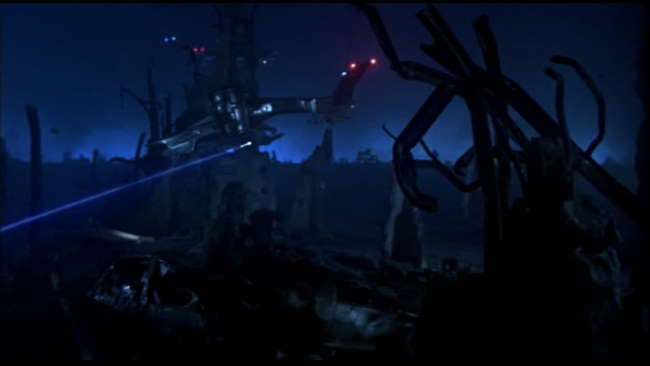
“You stay down by day, but at night you can move around. You still have to be careful because the HK’s use infrared…they’re not to bright…John taught us ways to dust them…”
Guerilla Filmaking: In watching the most awesome extras on special edition DVD, it’s clear that the Terminator was way over-ambitious (thank God!). In post-production, it was clear to Cameron that a number of additional unfunded scenes were needed in order to make a complete picture. Cameron used his weekly director’s pay to pay skeleton crews to go out and do additional shots – often which used incredibly low-end effects. For instance, the body bag used at the end was actually Cameron’s suit bag. The scene at the beginning where Arnold breaks into the station wagon was filmed with just him and Cameron, worrying about the police seeing them as Arnold breaks the car window (Arnold’s clothes for the scene were in his trunk – he had to change in the car!). More incredibly, the last shot of the Terminator, where the red eye slowly fades, was shot later – the smoke you see there was someone breathing cigarette smoke on the eye! In short, everyone gave blood, sweat and tears to make sure this film looked as good as it did.
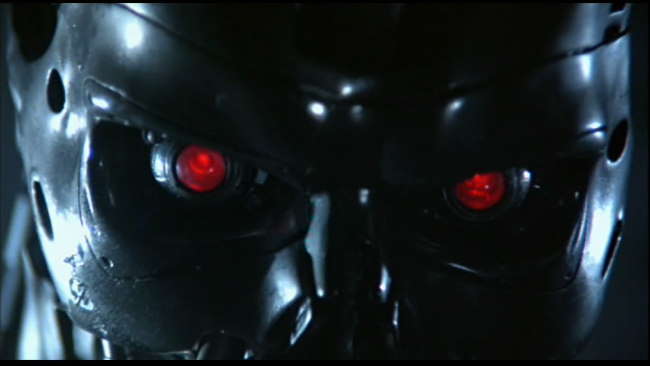
“That terminator is out there…it can’t be bargained with…it can’t be reasoned with. It doesn’t feel pity, or remorse…or fear. And it absolutely will not stop - EVER - until you are dead!”
The Bottom Line: The mood, energy and intensity of The Terminator oozes from every pore of the first shot to the last. If you are one of the very few who has not experienced this movie, you’re in for a treat! If you’ve seen it before (many times even), chances are you’ll be seeing it again. The Terminator definitely deserves a place of honor in the pantheon of cyberpunk flicks. One problem this film does give from a categorization perspective - they call the Terminator a cyborg, but he is really an android (even Cameron calls him this on the extras). The definition of a cyborg implies an augmented human, not an android covered with human tissue. I give it 9 stars as a movie, but add an additional star for its overall impact on film making.
Terminator Page 2: More Screencaps–>>
~See movies similar to this one~
Year: 1999
Directed by: Andy & Larry Wachowski
Written by: Andy & Larry Wachowski
IMDB Reference
Degree of Cyberpunk Visuals: Very High
Correlation to Cyberpunk Themes: Very High
Key Cast Members:
Neo: Keanu Reeves
Trinity: Carrie-Anne Moss
Morpheus: Laurence Fishburne
Agent Smith: Hugo Weaving
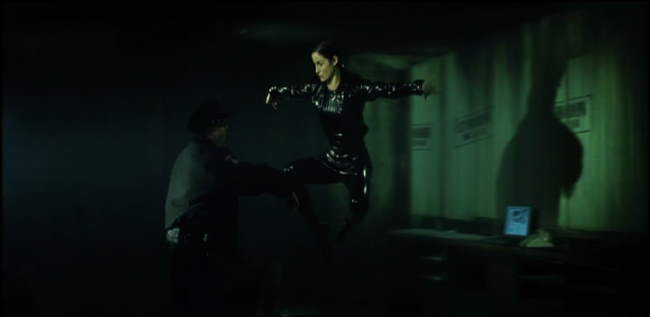
Definitely my favorite opening sequence of all time. Just a great great start to a movie!
Overview: The Matrix is one of my all-time favorite movies, so I’m just not going to attempt to come off as unbiased about it. Additionally, I’m guessing that pretty much everyone who’s coming to this site has seen it - probably numerous times, so I’m guessing a plot description isn’t of much value here. In short, my conundrum with the review is this - what should I say about this movie that will in any way add value to the reader? Answer: Not much. Instead I have decided to keep the bulk of my comments for various essays on the Matrix Trilogy.
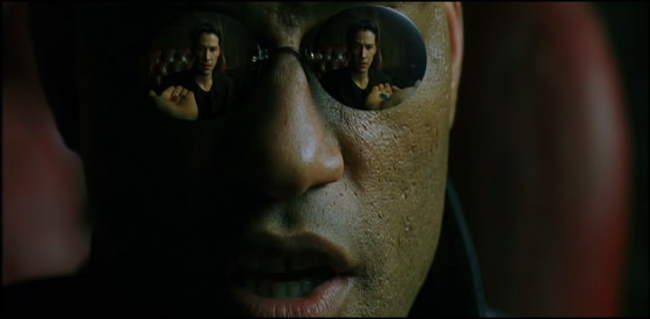
Matrix Influences: The Matrix influenced movies in general and society as a whole. With respect to movies, we see numerous influences, including:
- Special Effects: Bullet time and a myriad of other FX are now standard practice in movies and commercials
- Synonymous with “Cool”: Movies that have a “matrix-like” feel are advertised all the time. We know what this means - it means they aspire to be ultra-sleek, ultra-cool and the “in” thing.
- Fight Sequences: By hiring Hong Kong Martial Arts master Yuen Wo-Ping to coordinate the fights, the Matrix raised the bar on mainstream American movie fight sequences
- Matrix Source Code: The Matrix source code, taken in part from Ghost in the Shell, is everywhere now, and is instantly recognized, as is its meaning
- Hot Chicks in Black Shiny Stuff Kicking Butt: Trinity’s influence has massively upped the anty on action chicks in movies. While Michelle Pfeiffer’s Catwoman in Batman Returns re-initiated this trend, Carrie Anne Moss’ Trinity has made this outfit almost mandatory for female action heroines.
- The use of philosophy in movies: The Matrix seems to have broken the barrier to discussing philosphy in movies. Lets hope this idea lives on.
- Fashion: From Sunglasses, to overcoats to cyberpunkwear, the Matrix has changed the way people dress.

The Bottom Line: The Matrix is already one of the most influential in science fiction, and is truly one of the cornerstone cyberpunk movies in existence. We get it all here: terrific action, awesome cyberpunk concepts, incredible cyberpunk visuals, cool philosophical discussions, an absolutely awesome soundtrack (although DoomAng3l disagrees with this - see his comment below) and innovative FX. On top of this, all the leads were terrific. Reeves makes a perfect Neo, and Moss, Fishburne and Weaving give career-defining performances. Look below for move screencaps on page 2, and additional essays on the Matrix.
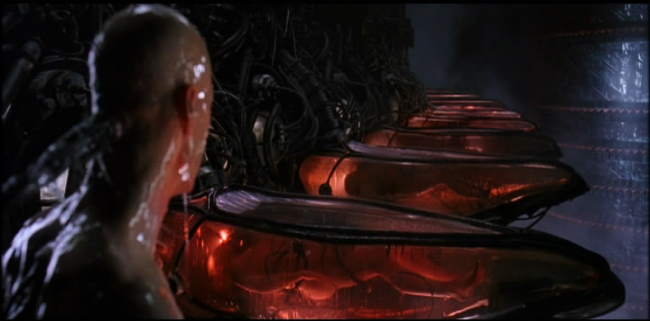
Matrix Essays
- The Matrix Trilogy: A Man-Machine Interface Perspective: This essay explores the Matrix Trilogy specifically from a scifi perspective - the purpose of which is to show how Neo’s journey is really a sequel to Motoko’s transformation at the end of Ghost in the Shell. Developed throughout the trilogy, Neo becomes a fully merged entity comprised of a sentient program with a human.
Page 2: More Screencaps–>>
~See movies similar to this one~
Year: 1993
Directed by: Hiroshi Fukutomi
Written by: Yukito Kishiro (Manga), Akinori Endo
IMDB Reference
Degree of Cyberpunk Visuals: High
Correlation to Cyberpunk Themes: Very High
Key Cast Members:
Gally (Alita): Miki Itô
Ido: Kariya Shunsuke
Yugo: Kappei Yamaguchi
Chiren: Mami Koyama
Vector: Shigeru Chiba
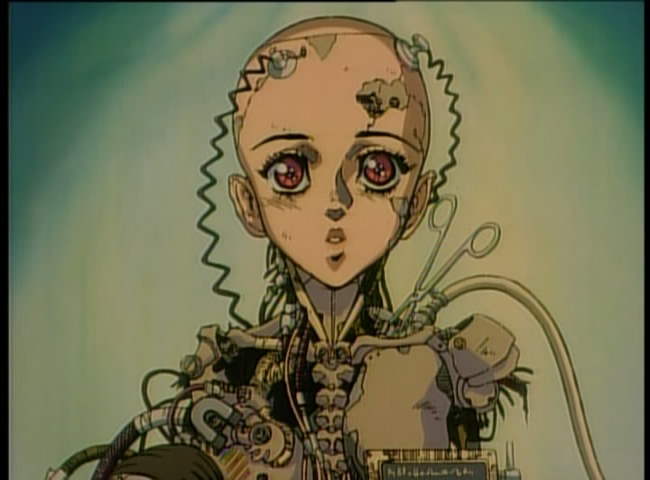
Overview: Battle Angel is based off a very well done Manga series called Battle Angel Alita. The movie covers the first two volumes of the Manga: Rusty Angel, which documents Alita’s “rebirth” and Tears of an Angel, which portrays a tragic love story. This anime from 1993 is one of the best man-machine interface animes out. The story is solid, and the drawing for that time period is terrific. While you might hear some gripe that the Manga is better, I think Fukutomi did a terrific job in taking Kishiro’s story to anime. I can only hope that James Cameron does a similarly wonderful job with the upcoming live action version of this. Just a warning - this is not a kids story - it contains lots of blood, head removals and minor amounts of nudity.
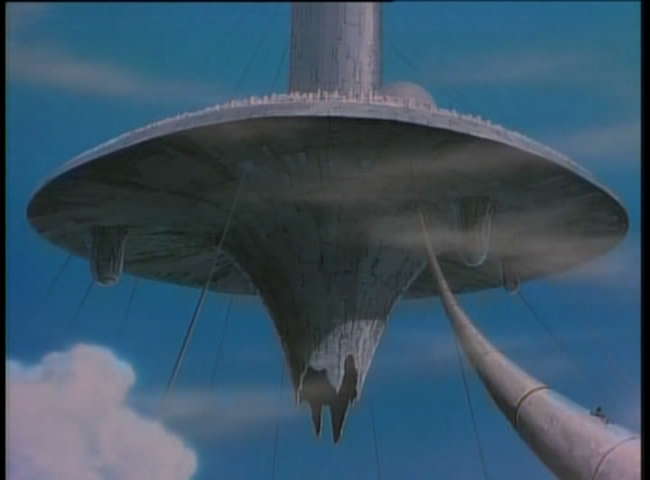
The Setting: Battle Angel takes place far into the future, after a societal collapse has occurred. Advanced human society has been relegated to a floating city called Zalem, that sits above a refuse heap called Scrap Iron City, which is inhabited by denizens living off the scraps and waste products Zalem expels. A corporation called the “Factory,” the primary employer for Scrap Iron City, sends products back up to Zalem through a series of huge metal tubes. Cyborg technology has become a way of life, with many “humans” having only their brain remaining from their original human body host. Scavenging and theft has become a way of life for many. Backbones are a particularly sought after commodity by thieves, who sometimes will violently take them from their living hosts. As social services no longer exist, the Factory posts “bounties” for the heads of the most egregious villians, which bounty hunters, called Hunter-Warriors pursue for money.
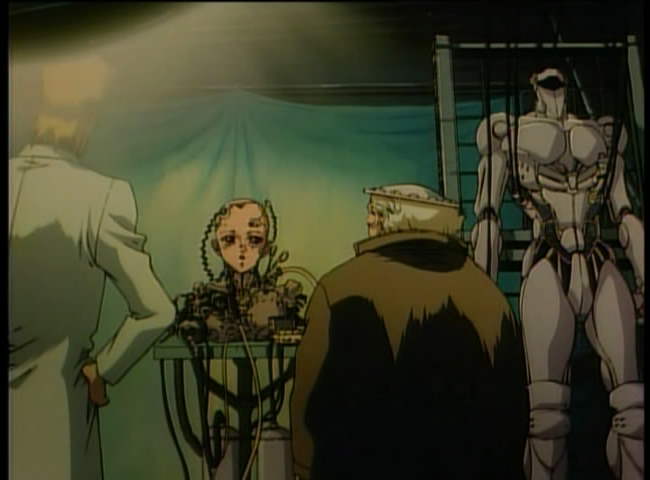
Rusty Angel: Daisuke Ido, an cyborg doctor extraordinaire, former citizen of Zalem, scavenges through the refuse heap to find spare cyborg parts to repair the citizens of Scrap Iron City. One day he comes across a female cyborg head that has a still-living human brain in it. He sets out to repair this head and gives her a wonderful body off of parts he has collected. He names her Gally (she is called Alita in the Manga), and she seems totally restored, except for the loss of memory from her earlier life. Ido becomes attached to Gally and they quickly develop a father-daughter type relationship.

Gally learns that Ido moonlights also a Hunter-Warrior both for moral reasons and to support his medical practice. Gally saves Ido from certain death, and thus, reveals that she, in her former life, was also a very talented warrior. Under protest from Ido, Gally asserts her individuality and desire to become a Hunter-Warrior like Ido, so that she too can have purpose to her life.
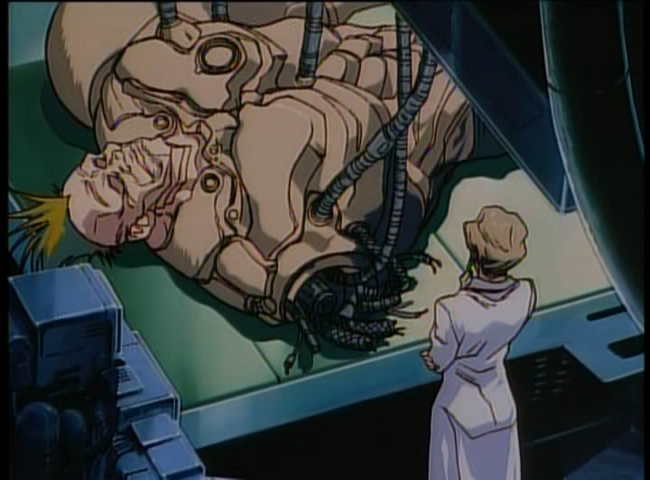
Chiren, also a cyborg doctor and Ido’s former partner, has also been ousted from Zalem, and is consumed with finding a way to return. Deciding that she will do anything to make this happen, Chiren hooks up with Vector, a shady character who has connections with the “Factory,” who agrees to eventually take her to Zalem in return for sexual favors and for her assistance in building a supra-cyborg gladiator named Greweicia for the fighting ring. This cyborg warrior also has a penchant for eating brains, and ends up on the bounty list. Chiren, wanting to be seen as superior to Ido, gets Greweicia to fight Gally in the hopes of destroying her, and thus, destroying Ido.
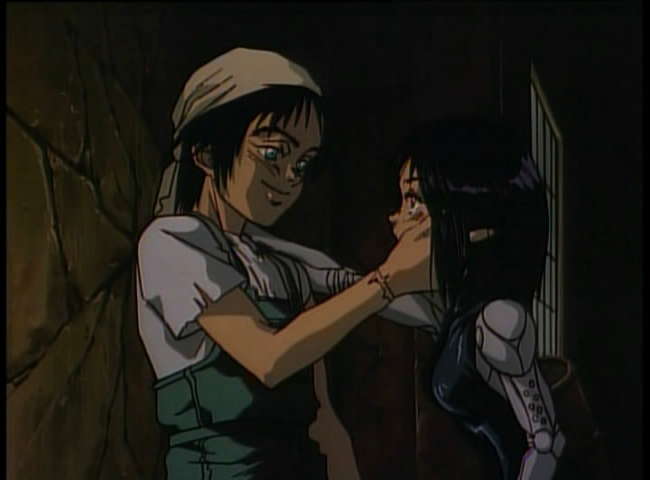
Tears of an Angel: Gally, in exploring the city has become infatuated with a hard working body named Yugo, who dreams of going to Zalem. Although it’s common knowledge that nobody born in Scrap Iron City can ever go to Zalem, Yogo is also consumed with finding a way, and has gotten an agreement from Vector, who promises Yugo if he can make 10,000,000 credits, than he will take Yugo to Zalem. Yugo has taken him up on his offer and has started stealing cyborg spinal cords as a way to augment his day job of fixing machinery. He is discovered, and is put on the Bounty list. Gally, who has fallen deeply in love with him, tries to rescue him from a rival bounty hunter. Unfortunately she is too late, but is able to save his head, and asks Ido to turn him into a cyborg. Even after becoming a cyborg, Yugo’s dreams of reaching Zalem cannot be abated, as he sees his life a struggle against the worthlessness that is the Scap Iron City.
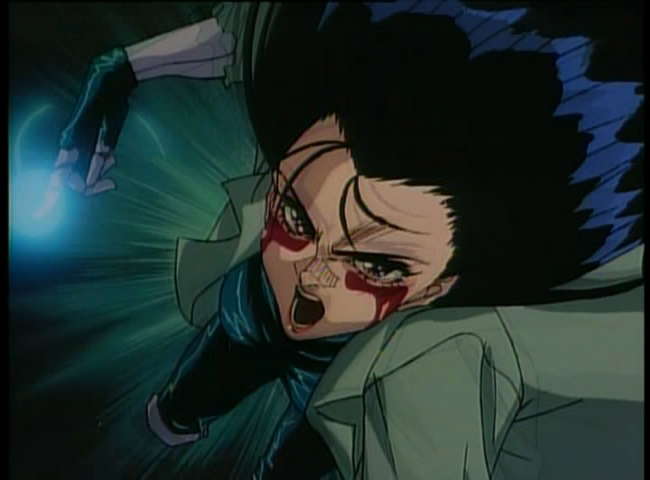
The Artwork: In Battle Angel, we see strong influences of Akira in most every aspect of the production. From the facial expressions to the darkly textured backgrounds to the fighting style approach, Battle Angel clearly has used Akira as a template for modern animation techniques. Like many OAVs of this time period, some of the backgrounds are bland while others are lavishly penned and inked with multi-layered designs. They “pick their battles” with the designs, but for the most part, the decisions are solid. The simple designs are in backgrounds such as the sky and in Ido’s house. The more complex ones are in the underground, Yugo’s hang out, and in the refuse heap scenes – this is where most of the action and plot take place.
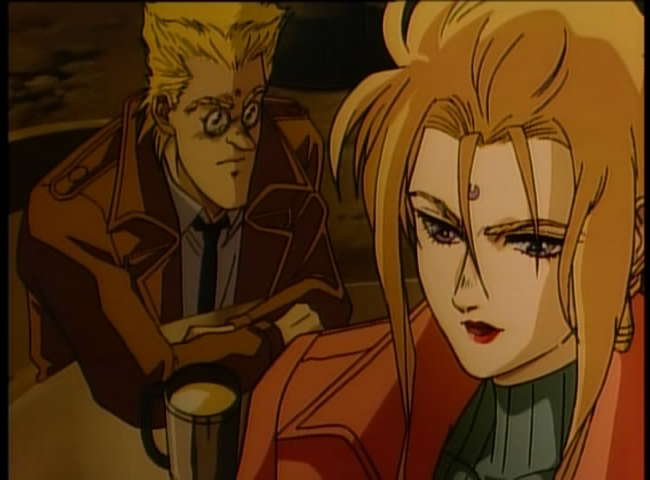
Changes from the Manga: While I think Battle Angel is a terrific anime, there are some changes from the Manga that some find annoying. Most bizarre is the renaming of Alita to Gally, and the city Tiphares to Zalem. However, unlike some, I don’t find the changes in the plot to be that problematic. The anime wonderfully captures the essence of the Manga. Perhaps the biggest change is the rationale for Alita’s powers. In the anime, we really don’t get an explanation, but in the Manga, Alita is first given a normal body by Ido, and ends up destroying it in her first fight. Realizing that Alita is a warrior at heart, Ido gives her the body he has saved for a long time – that of a berserker warrior. The primary villain in Rusty Angel is also different – he is a being who has grown up in the sewers, and after losing his body in fighting Alita, he takes over the Gladiator’s body. And Chiren, a central character in the anime is not in the first to novels of the Manga. Again, for the most part, I have no problems with the changes, and actually love the dimension that Chiren adds.
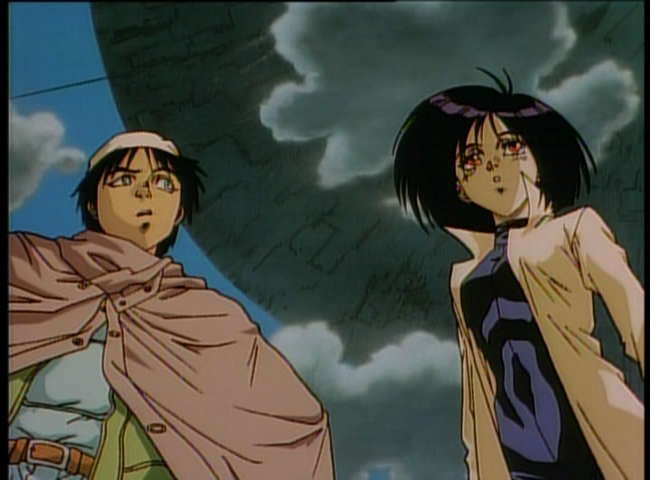
The Bottom Line: Battle Angel (Alita) just works for me as an anime. It is intelligent enough and well enough executed to get you to imagine a world where cyborgs are a reality. The world from the underground perspective is well done and Alita (I call her Alita, not Gally) as a character is terrific. Along with Armitage III and Ghost in the Shell (obviously), Alita is one of the best animes of this kind. Just a caution for those who have only seen the VHS, like most Japanese animes, Battle Angel comes off FAR FAR better with the Japanese dubbing cast than it does the English cast.
~See movies similar to this one~
Year: 1971
Directed by: George Lucas
Written by: George Lucas (story and screenplay), Walter Murch (screenplay)
IMDB Reference
Degree of Cyberpunk Visuals: High
Correlation to Cyberpunk Themes: High
Key Cast Members:
THX 1138: Robert Duvall
LUH 3417: Maggie McOmie
SEN 5241: Donald Pleasence
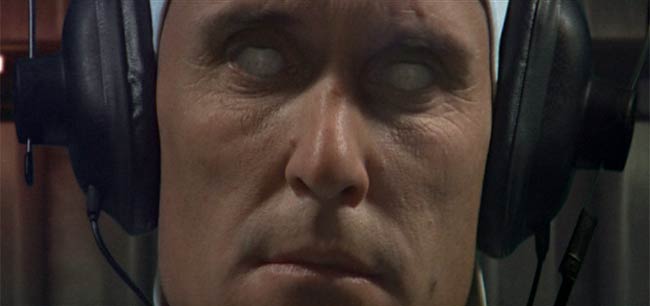
Overview: George Lucas’s THX-1138 is one of the many good small-budget films long forgotten that has found new life on DVD. THX-1138 gives us a wonderful commentary on how Lucas, back in 1971, thought society would be if those in power ever really got their way. Everything here is antithetical to the 60s movement. Freedom and in fact most of humanity is squashed in this depiction of a dehumanizing nightmare society. All actions are controlled and securitized to ensure compliance.
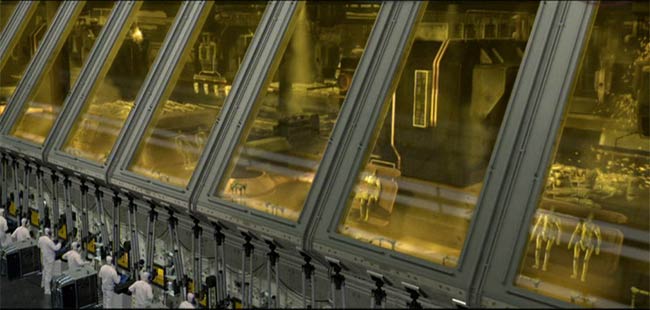
The Setting: THX-1138 takes place in an underground facility in some ill-defined future where all aspects of humanity have been squashed. Everyone has all individuality removed, including possessions, hair (everyone has shaved heads). Humanity is controlled by television brainwashing combined with medications that remove human emotions. All citizens have a have a specific role to perform, and must adhere to completely programmed time schedules. Regularly scheduled “confessions” with mind control officers are used to catch any unexpected problems with individual expression. In this setting, Robert Duvall, known as THX-1138, and his room mate “dare” to have affection for one another.
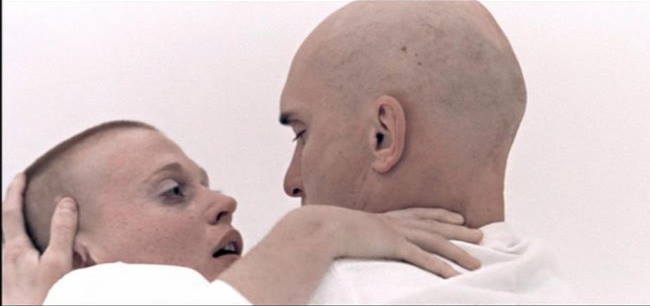
A series of events occur which make THX-1138 disenchanted with society. He begins to cut down on his medication, and convinces his room mate, LUH 3417 to do the same. When emotions return, so does their humanity. They begin to find emotional desire and love for one another, but this is cut short, when a ranking facility member, SEN 5241, decides he would prefer to have THX-1138 for a room mate, and removes LUH 3417. But THX-1138 has gone too far, and instead, seeks out a budging resistance movement. Unfortunately for him, the control group has discovered his deceit.

The Visuals: Like many cyberpunk films, dominating color schemes are used for conveying the moods. In this case, white is used to depict dehumanized society; yellow is used for the controlling machinery, and darkness is used for the unknown innards of the facility’s inner-workings. THX-1138 provides much of the storyline through its visuals. We aren’t told the history of this futuristic dystopia, nor are we given much indication of how this society is run. As an interesting side note, although its never stated, one really gets the feeling in watching this that the powers that be would strongly prefer replacing humans with emotionless robots.
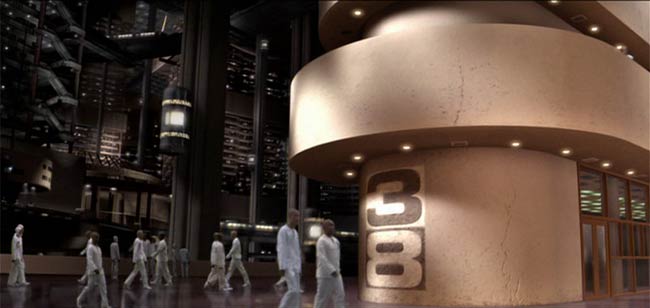
Changes to the Original Release: I have only seen the director’s cut of THX-1138, so I cannot comment on the original cut. However, I notice a similar level of anger to this version as was seen in changes to Star Wars. I probably need to track this down, but not having seen it, I don’t really see many of the problems they list, including poorly integrated CG effects (the shot above is an example of added CG into the background). Many also complain that while the film length is the same, some shots are missing. I don’t notice any complaints about changes to the sound, which seems very well engineered to me. Again though, having come to this movie without seeing the earlier version, I do have a hard time with people stating there is no value to this version, or that it is so far worse than the original that it is not worth watching. These sentiments seem like severe overkill. Still, like Star Wars, one hopes that the original eventually gets released as well.
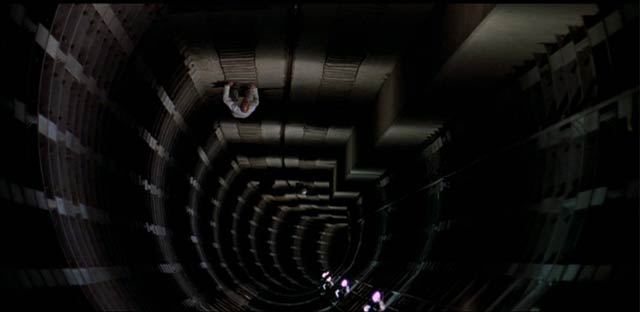
The Bottom Line: THX-1138 is a very well made low-budget art film where Lucas takes the controlling elements in society to what he sees as their logical conclusion. While this isn’t very realistic in many ways, it certainly sends a powerful message. The pacing is consistent and the themes, while not new, are interesting and well conveyed. As long as you’re not looking for lots of action, you will probably enjoy this.
~See movies similar to this one~
Tags: cyberpunk movie review THX-1138
Year: 1995
Directed by: Kathryn Bigelow
Written by: James Cameron (story and screenplay) & Jay Cocks (screenplay)
IMDB Reference
Degree of Cyberpunk Visuals: High
Correlation to Cyberpunk Themes: High
Key Cast Members:
Lenny Nero: Ralph Fiennes
Lornette ‘Mace’ Mason: Angela Bassett
Faith Justin: Juliette Lewis
Max Peltier: Tom Sizemore
Philo Gant: Michael Wincott

Overview: Written by James Cameron, Strange Days is a near-future (now in the past as it takes place the day before Y2K) film noir written that puts the “punk” in cyberpunk. This is truly a great underground ride. Strange days is about a down and out former vice-cop named Lenny (Ralph Fiennes), who’s life has long since seen its better days - he now makes his living, such as it is, by selling illegal VR experiences (sexual and high tension experiences) that can damage the brain if played too often. In this “near future,” people can capture VR “experiences” by placing a “Jack Thursby-like” thing on their heads (called a Squid) to capture their emotional experience. Ralph wants more than anything else to have his former girlfriend back (played by Juliette Lewis) - who is now in the clutches of a sadistic music producer. During the course of his “practice, Ralph comes upon a data disc that has recorded a murder of a prostitute. Ralph follows the trail, which leads him into the pit of humanity, with seedy scenes, blackmail, murder and rape. Ralph’s friend (played by a very hot Angella Bassett) is the voice of reason in this, not to mention an awesome ass-kicker!
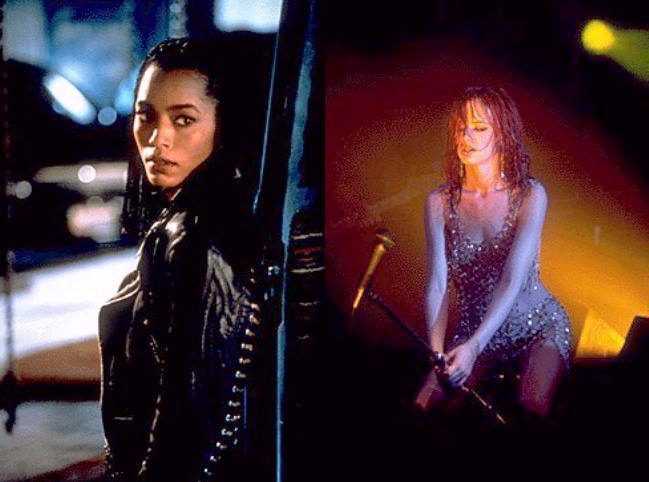
The Bottom Line: This movie is really more “punk” than cyber, but it does have enough to matter. Besides the rather simplistic recording of memories, Strange Days gives us a potential view of humanity in decline as technology becomes more and more invasive in our lives. On top of this, the seedy near-future settings are great, and all the lead actors in this are terrific, including Tom Sizemore (Lenny’s best friend) and Michael Wincott (the psychopath).
However, I do have to knock one point away due to a 4 year predictive window - in 1995, I cannot imagine anyone thinking that the year 1999 would have resembled anything like this. Yes, Snow Crash had kicked the 3D Virtual Worlds movement into high overdrive, but no, 4 years was way too quick for a prediction such as this.
~See movies similar to this one~
Tags: cyberpunk movie review StrangeDays
Year: 2004
Directed by: Jeff Renfroe & Marteinn Thorsson
Written by: Jeff Renfroe & Marteinn Thorsson
IMDB Reference
Degree of Cyberpunk Visuals: Medium
Correlation to Cyberpunk Themes: Very High
Key Cast Members:
Simon J.: Jeremy Sisto
Derrick: Udo Kier
Howard: Lance Henriksen
Trish: Deborah Kara Unger
The Neighbour: Bruce Payne
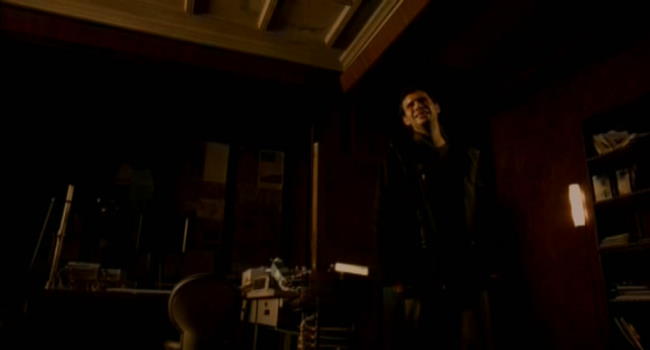
There are good people and there are bad people and they’re on their way,
and they want you, Simon…
The bad people can save you, but they won’t…
The good people want to save you but they can’t…
Overview: Every now and then I run across an absolutely extraordinary cyberpunk film, largely forgotten or ignored by the film going masses. More often than not, this film is foreign and never had a decent release in the US (where I’m from). One Point O (called Paranoia 1.0 in the US) is European a film that meets these criteria. Truly, you’ll be hard pressed to come close to finding an immersive film as One Point O. When you consider this was reportedly shot and produced on a budget of 1.7 Million, you begin to understand the enormity of what was accomplished here. No, you don’t get cool explosions or guns, or fancy CG effects, but you do get an absolutely awesome near-future dystopic story with a biting commentary on advertising and software development, all wrapped up in an extremely immersive, slow paced film. Everything is subordinated to the mood here, which is emphasized by the color choices and simple score. Unfortunately, I will need to be pretty vague in this review, as the ending definitely has a Sixth Sense type feel to it.
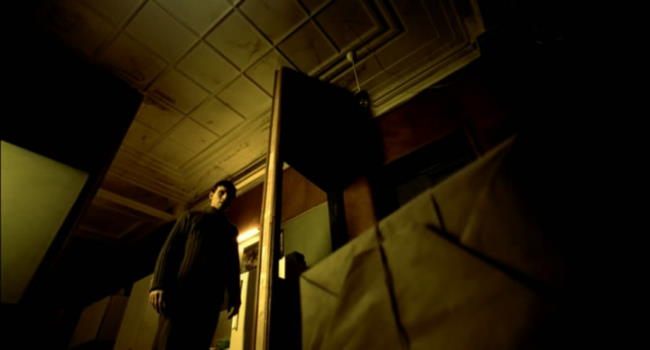
One Point O is about a computer programmer named Simon who works at home in a truly dingy, run down apartment building in a very shabby part of the city. He comes home to find a package waiting inside his apartment, and gets worried as nobody should be able to get inside. He opens the package, only to find that it was an empty box. This happens again and again, each time making Simon more and more paranoid. One top of this, he is late in delivering his the code he’s been working on to his customer. It appears as if his code has become infected with a virus, and worse, he really has a craving for milk!
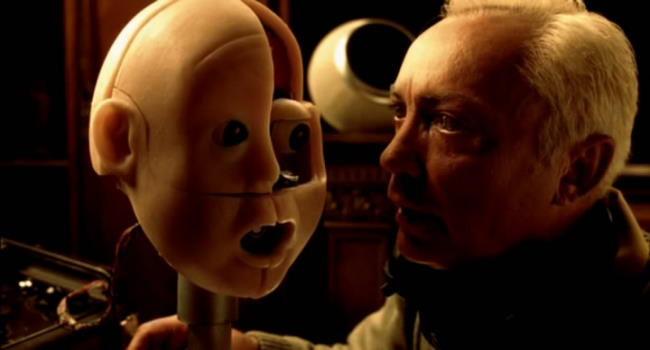
Every character in One Point O is quirky and memorable. Udo Kier (Ralfi from Johnny Mnemonic), one of my favorite role actors, plays an eccentric robotics hobbyist who has a nanotechnology-enabled couch that changes colors and cleans itself at the click of a button, and creates a sentient talking head in his spare time (this talking head named Alex has a penchant for making very prescient phone calls). Bruce Payne (Passenger 57, Hellborn) plays a neighbor VR game maker who creates S&M VR porn experiences by acting out the scenes with various partners. Deborah Kara Unger (Fear X) plays a cancer nurse in search of fleeting humanity wherever she can find it. Lance Henriksen (Bishop in Aliens) plays a strange, zen-like repairman who always seems to know what’s going on. Finally, Emil Hostina places a voyeuristic landlord who loves to eat meat. But its Jeremy Sisto who steals the camera - he’s simply terrific playing a normal guy overtaken by extremely weird events.
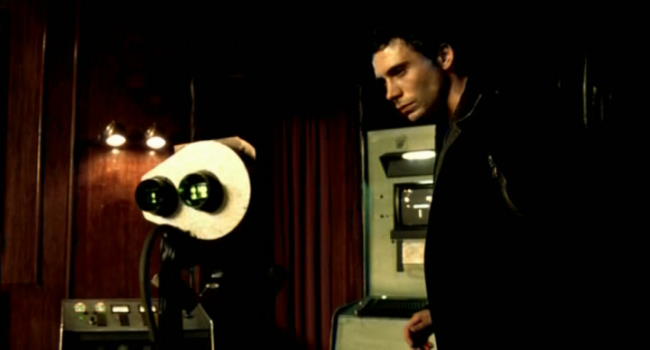
The Visuals: Like many cyberpunk movies, One Point O is dominated by a single color scheme - in this case we get a spectrum, from a yellow to pale orange to reddish-brown, with an occasional pale green as a highlight. Pretty much the whole movie (with the exception of the white convenience store which represents the corporation) takes place in those colors. Further accenting the dystopic quality is the continually run-down feel of the place. The apartment building is continually falling apart, as is virtually everything else except for the local drug store. While its clear that advanced technologies are the norm in this world, the people in One Point O have clearly been marginalized. They play with patchwork toys and out of date technology.
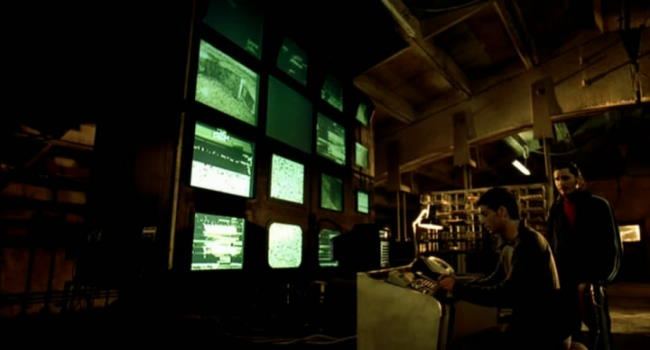
The cinematography is consistently interesting in One Point O, with many using floor shots with expansive backgrounds. However, in some cases, they probably go a bit over-board on the camera angles, such as the use of the close-up phone shot of old, which actually took attention away from the story telling. But again, this is a minor gripe, especially when we include the editing, which for the most part, is also outstanding. But in watching the deleted scenes, I do agree with the director’s commentary that a few shots probably should have been included, most notably the throw-up scene.

The Message: While I can’t go into the actual plot for fear of ruining the experience, I will say that One Point O has perhaps the most biting commentary on advertising and software development you will find anywhere. There is no question who is evil in this movie, even if they are rarely seen. Renfroe and Thorsson take to extremes and then crystallize problems they see in today’s world that form the basis for the story in One Point O. But they don’t state it in an in-your-face way - far to the contrary in fact. The story itself hammers home the message in the starkest manner possible.
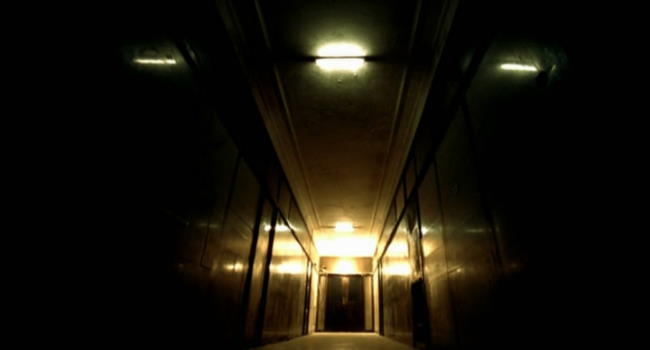
The Bottom Line: As long as you’re not looking for action or sleak visuals, but instead are looking for original cyberpunk themes done wonderfully well on a shoestring budget, One Point O is for you. One Point O is definitely a movie I would LOVE to talk about in detail but I cannot for fear of spoiling the terrific ending (maybe creating a spoiler thread in the meatspace would be the way to discuss it). The pacing has a slightly repetitive feel to it, but only because the movie progresses in a spiral pattern - the same basic pattern of events happen each pass, but events spin further and further out of control each time around. But again - go buy this movie (you’ll want to watch it more than once) - you won’t be disappointed.
~See movies similar to this one~
Tags: cyberpunk movie review paranoia
Year: 1994
Directed by: Hiroyuki Ochi
Written by: Akinori Endo, Chiaki Konaka
IMDB Reference
Degree of Cyberpunk Visuals: High
Correlation to Cyberpunk Themes: Very High
Key Cast Members:
Armitage: Hiroko Kasahara
Ross Sylibus: Yasunori Masutani
D’Anclaude: Ryûsei Nakao
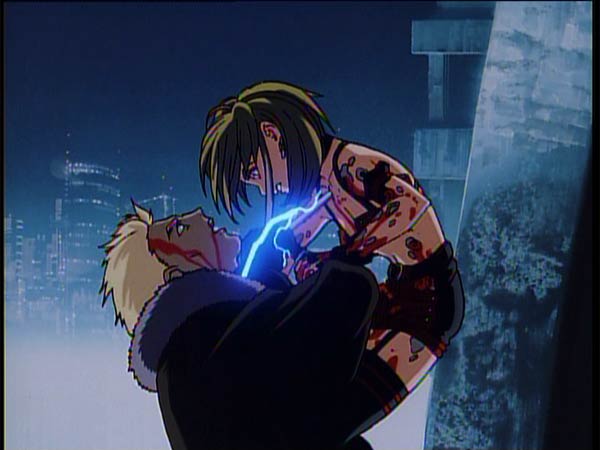
Overview: Armitage III, one of the many Chiaka Konaka written masterpieces (along with Serial Experiments Lain, Texhnolyze, Malice@Doll) is simply an awesome story. If you like Blade Runner and haven’t seen Armitage, you’re doing yourself a disservice. Most of the same issues are raised there, but are done in an original enough way that makes you absolutely love this little anime chick. Humanity as an exclusionary concept which also implies “worth” is fully explored here. Are androids still supposed to just be our servants even if they do have a sense of self-worth?
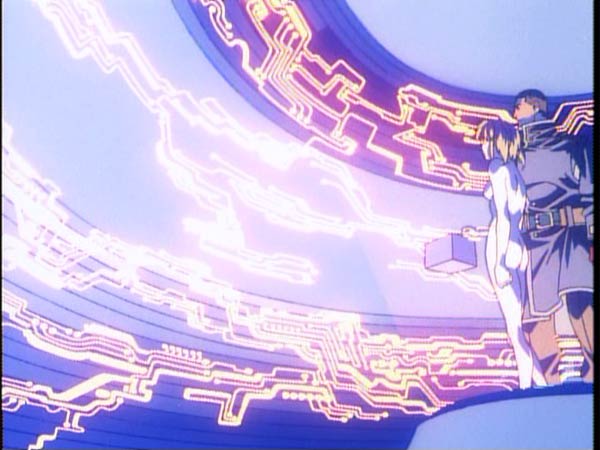
Set in a Blade Runner-like future, mostly centering on Mars, Naomi Armitage is a type III series android who works as a cop on Mars, along with her new partner, Ross Sylibus. While most of the public knows about, and barely tolerates the type II series, they are not aware that there are a few lifelike, human-acting type III series androids living among them. Unfortunately for the robots though, someone knows of their existence and is systematically killing them one by one.
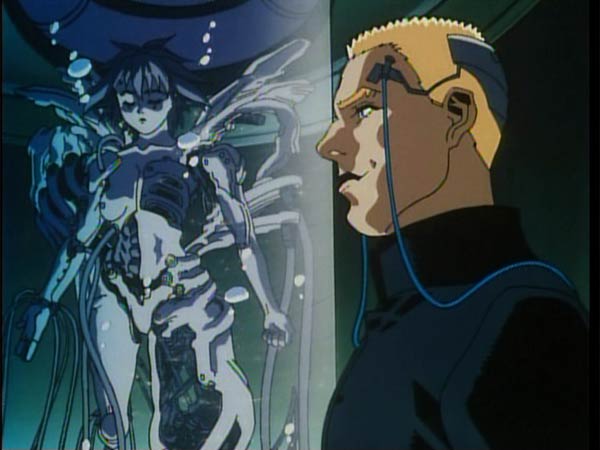
As the plot progresses, Ross, who doesn’t like robots (his former partner was killed by a cyborg) learns that Armitage is an android. Even worse, they learn that the murderer is a series IV robot. Armitage, who starts off as a wise-cracking, disrespectful cop who dresses in sleazy clothes starts to question her “humanity” such as it is. In addition to realizing she’s one of the very few left, Armitage wonders why she was ever created. As she struggles to maintain “sanity,” Ross begin to develop a closer relationship - one that is not too mushy, and works well with the pacing.
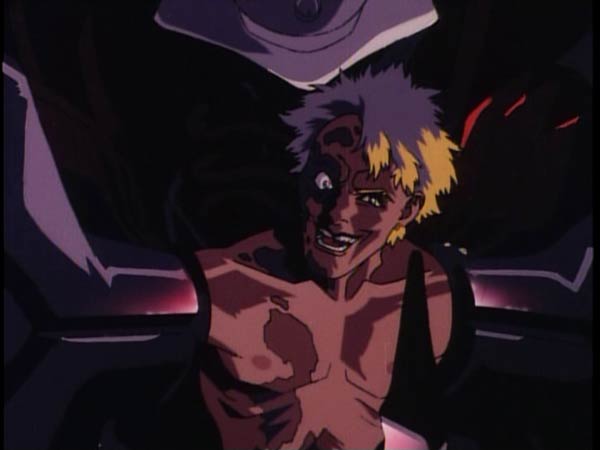
Armitage eventually broadens into a large-scale conflict that involves greedy corporations, inter-galactic disputes, android’s rights, population issues, and all the rest. We get LOTS of gun fights in this, and even a full scale battle, mecha style. In addition to being cute and vulnerable as an android wondering if she has a purpose in life, Armitage also kicks major ass in her burgundy leather ensemble. Guts, martial arts and all sorts of other gadgets come flying out of this chick. She is definitely, tough, strong willed, and lots of fun to watch.
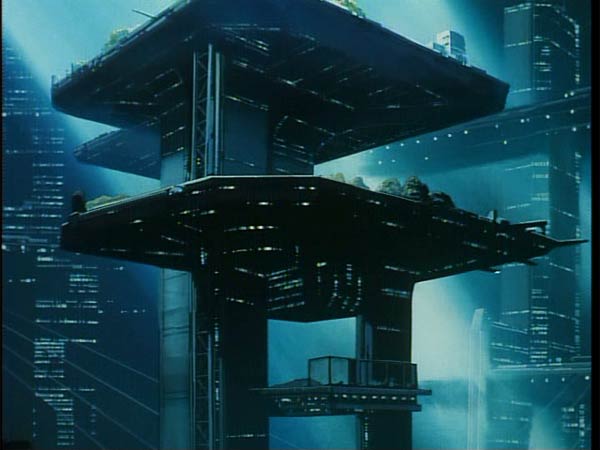
Notice the incredible similarity to another futuristic building in Metropolis.
The story is one of the most compelling in cyberpunk anime and really makes you feel for Armitage. Yes, the whole questioning of humanity by an android has been done before (and since) and since, but Armitage is definitely one of the better ones at this. Within the confines of a murder investigation, Armitage’s “soul” is exposed in her search for larger meaning and purpose, all while her fledgling relationship with a cyborg-hating policeman begins to emerge. Interesting questions are posed such as, what happens if an android has a fatal flaw? Should we throw them away is if they are they truly nothing more than a toaster? This is in essence a mirror to questioning how we deal with handicapped people in human society. We still consider handicapped people valuable and contributing members to society, but would we do the same with disabled Androids? At what point do they become real as opposed to simply remaining property - a tool for humanity?

The Bottom Line: The visuals and sounds in Armitage III, while good, are somewhat dated and inconsistent. Some shots are absolutely superb, while others have a relatively plain background and almost 80s looking characters. Overall, there’s enough there to keep your interest, but its the story that delivers. Truly, I absolutely LOVE it!
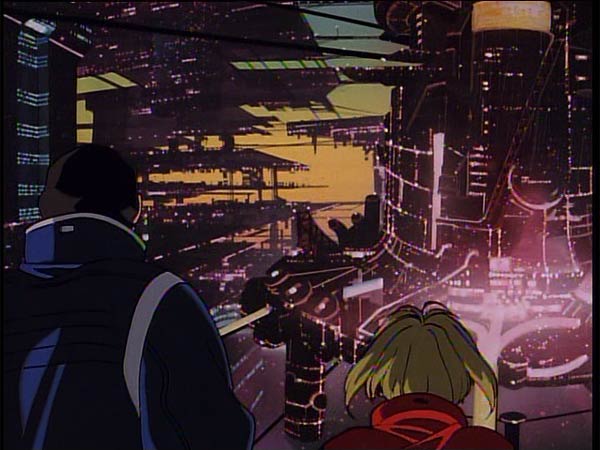
What is Armitage III Polymatrix? Polymatrix is a movie extracted from the 4 OAVs in Armitage III. While it is missing a few interesting scenes, its still watchable. It also has Kieffer Sutherland and Elizabeth Berkley as voice actors here, so if you can’t stand subtitles (You really fix this problem in the long run though), Polymatrix is a reasonable substitute. Some truly hate it primarily due to the English dubbing, the missing scenes and the changed ending. For me, I was OK with the dubbing, was generally OK with the scenes missing, but I liked the ending in the OAV (this movie) better.
~See movies similar to this one~
Year: 2001
Directed by: Mamoru Oshii
Written by: Kazunori Itô
IMDB Reference
Degree of Cyberpunk Visuals: Very High
Correlation to Cyberpunk Themes: Very High
Key Cast Members:
Ash: Malgorzata Foremniak
Murphy: Jerzy Gudejko
Game Master: Wladyslaw Kowalski
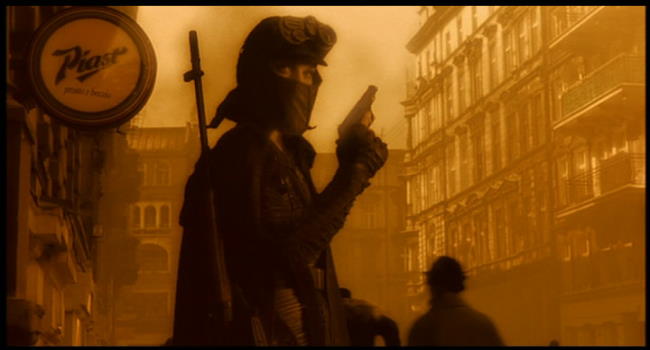
Overview: Mamoru Oshii, the master of philosophical cyberpunk animes ventures into a real world cinema production. The actors, dialogue and sets all take place in a Poland. Although this isn’t anime, the characters, cinematography and philosophy bare a striking resemblance to Oshii’s latest anime (which might show up on this list soon…). There is also many aspects of the Arthurian legend intermixed here, including the quest for the holy grail (understanding the nature of reality?), the search for the nine sisters of Avalon, and wizards, warriors and bishops. If you’re an Oshii fan, this is a must see. If you love VR game films this is a must see. If you like embedded philosophy and symbol laden movies, you will probably enjoy this. But if you’re coming purely for the action, there are probably better movies for you to spend your time on.
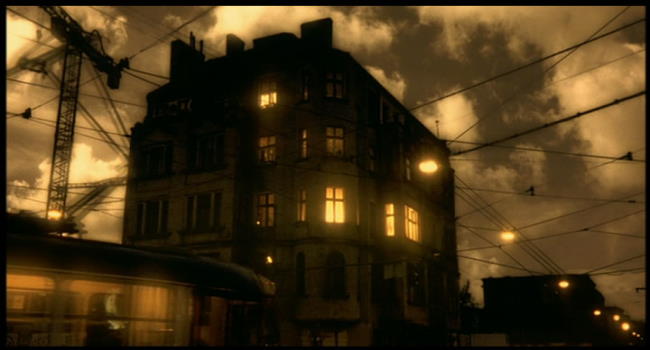
This movie takes place in a cyberpunk, dystopian future where the world is stark, devoid of real life or color, and where the only real enjoyment for young people exists in an illegal virtual reality game called Avalon. Avalon in mythical terms is the island where souls of the departed heroes come to rest. In the Virtual Reality Game of guns, tank and helicopter battles called “Avalon,” the players are the heroes, but there is a risk of actually becoming brain-dead while playing this game. In real life, the “unreturned” victims who never leave the game become human vegetables who sit around drooling in an insane asylum (this explains why the game is illegal).
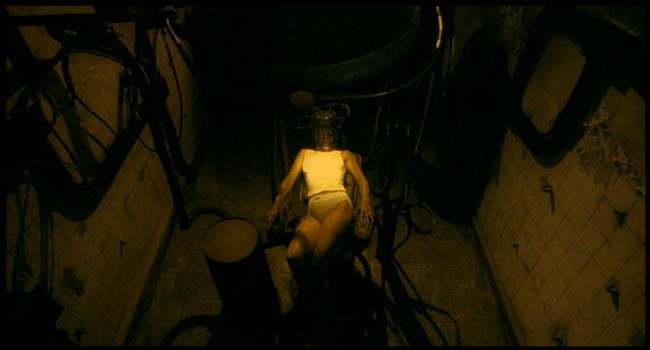
The main character is a hot warrior chick named Ash (wonderfully played by Malgorzata Foremniak). Once, she was a part of the best team in Avalon called Wizard. But something happened which caused one of the team members to panic under fire and call for a “reset” of the program (This is a traumatic action which causes all sorts of bad things to happen). This caused the team to disband and in Ash’s case, led her to be disconnected from all other players including Murphy, her team leader. Instead she becomes a supra-warrior who attempts to win the game going solo.
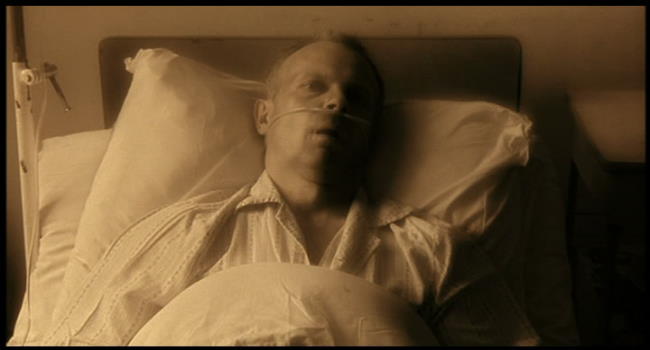
During her adventures, she learns that Murphy also went solo, and eventually worked himself up to finding a secret level called “Special A” that does not have a “reset” function. If you don’t complete the level, you don’t return. In essence, this level IS Avalon in the mythical sense. In Murphy’s case, he did not win, and ended up becoming one of the “unreturned” who lives out his “real” existence drooling in the asylum. Ash becomes obsessed with reaching this secret level so that she might find Murphy and return him. To complete this level, Ash needs to kill an illegal “unreturned” player. If she does wins, she will be offered a game admin job with Avalon. Unfortunately, Class Real is filled with “neutrals.” If Ash kills any neutral person she will lose, never to return.
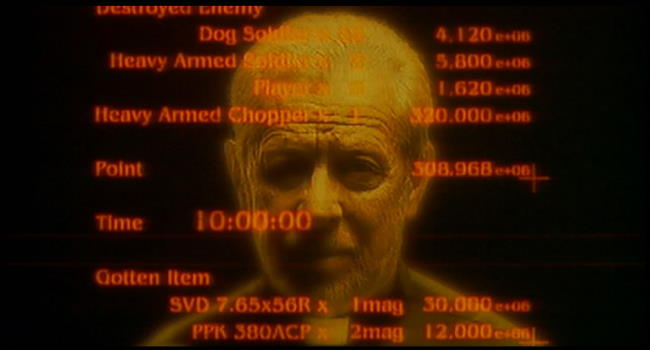
When Ash asks the Game Master if he’s real or not, his response is telling: “Does it matter if I’m real or not?” Like GITS:2 there is this notion that the line between what is real and what is imaginary almost doesn’t matter. What matters is what is actually occurring inside someone’s head: that is the “true” reality.
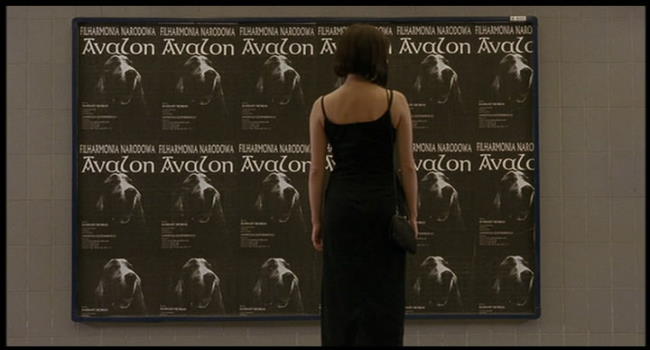
Use of a Dog as a metaphor for the “real” world: Again, similar to When Ash plays with her dog, she is participating in the “here and now.” Most of the time, Ash’s consciousness is situated in a timeless world where the actual real life moment is secondary to one’s perceptual reality. At one point early in the movie Ash wonders aloud, “Real life, is that what this is?” When she starts working at the computer, the dog goes to sleep, indicating that she has left real life and is in the game reality, if not in body, then definitely in spirit.
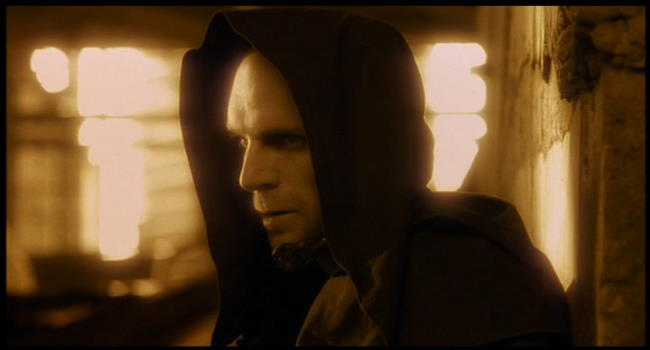
The cinematography: The cinematography in Avalon is strikingly familiar to Oshii’s latest anime. The same use of lighting, camera angles, and bright orange/yellow/brown tones are used. Interesting shots involving shadows abound. Throughout, the sets and camera pans are designed to elicit a closed-off, claustrophobic feeling. Everything, from Ash’s apartment to the train to the virtual reality headset rooms to the alleyways are bare and boxed in. Slow moving but sweeping pans add to the claustrophobia. Scenes are rarely at regular speed. Instead, the pacing is very slow moving to allow the audience time to take in the essence of the mood. In line with the pacing, Oshii continualy composes set shots similar to how he does in animes. In essence, we see glorious and elongated still shots of visually textured and wonderfully balanced objects.
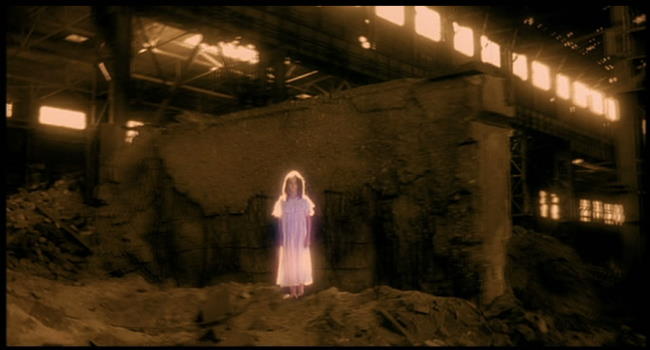
The FX and Sound: The special effects, while not on par with the high-end blockbusters, hold up well when compared to most VR type movies. Most impressive are the digitized explosions. When people and tanks "die" they digitally decompose in interesting ways. Similarly, when you enter the game, buildings auto-form. Also, the score is both haunting and moving. It highlights the slow build-up of thought and emotions. The mood of the film is clearly expressed through the score, which often serves as a catalyst for the pacing changes. As the major plot points change, so does the score radically follow suit. And the ending Avalon opera is just beautiful. I would pay to go see someone sing that.
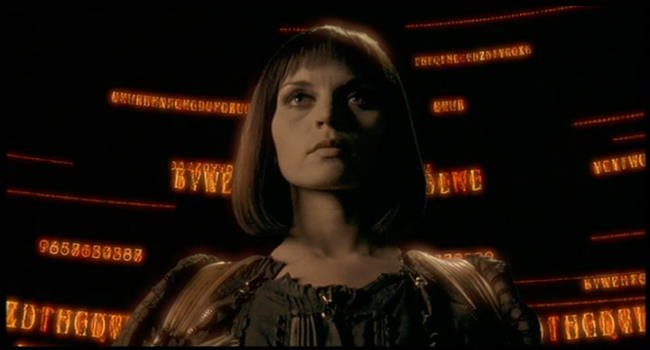
The Bottom Line: In short, Avalon is a wonderfully deep philosophical cyberpunk flick that fully explores whether reality truly matters. In essence, does it really matter if the fantasies we have running in our heads don’t really match the “reality” of the outside world? Or more to the point, is anyone really experiencing the reality of the outside world, or are we all just in our own personal Avalon? I hesitate to add more here, as doing so would spoil this most excellent movie for those few unfortunate souls who have yet to experience it. I have just one piece of advice - do so now!
But if you have seen it, I’d be happy do discuss detail philosophical thoughts with you concerning Avalon on Page 2: the Avalon Interpretive ending page. Many have expressed confusion over the ending, so I thought I’d share some thoughts on it. So if you have spoiler type questions about this movie, put them on page two (which also has more screencaps).
Page 2: Spoiler Discussion –>>
~See movies similar to this one~
Tags: cyberpunk movie review Avalon oshii
Year: 1995
Directed by: Mamoru Oshii
Written by: Kazunori Itô, Shirow Masamune (Manga)
IMDB Reference
Degree of Cyberpunk Visuals: Very High
Correlation to Cyberpunk Themes: Very High
Key Cast Members:
Major Motoko Kusanagi: Atsuko Tanaka
Batô: Akio Ôtsuka
Section 9 Department Chief Aramaki: Tamio Ôki
Togusa: Kôichi Yamadera
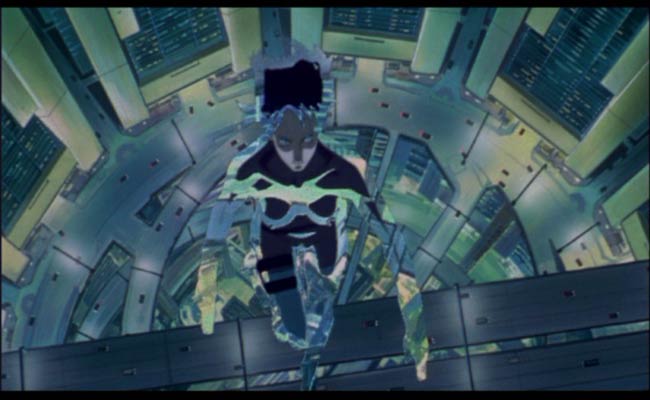
And where does the newborn go from here…the net is vast and infinite…
Overview: After Akira, a case can be made for Ghost in the Shell being the most influential anime ever. While Akira was the first anime to crack international markets, GITS rose anime to something “real,”, and opened the doors for events like Disney’s pursuit of Miyazaki, and eventually, the truly incredibly pace of anime we see today. More important for cyberpunk films, GITS provided a myriad of thoughts and visuals that have been expanded upon in virtually all subsequent cyberpunk animes. James Cameron refers to GITS as the first truly adult animation film to reach a level of literary and visual excellence.” In addition to a wonderfully complex and introspective story, we get heart-thumping, realistic action, all served up with some incredibly revolutionary animation techniques that places GITS on a juicy platter for all to enjoy.
~ Fair warning - there are a few plot spoilers below in the matrix discussion - I simply couldn’t write this, especially with linkages to the Matrix without including an interpretation of the ending of GITS. ~

GITS shows us a very realistic looking near future set in the year 2029. The visuals are intricately detailed and depict grunge settings next to the highly sanitized corporate world. In 2029, people have the ability to augment their bodies with cybernetic replacement parts. In some cases, people have almost fully replaced their human bodies, leaving only their brain encased in a cyborg shell. The brain is even augmented with hyper-intelligent access to knowledge and communication packages. But the person, and we use that term loosely now, still has a ghost, or soul if you will - an emergent property of life that separates a human from a robot. Even though the majority of their human material is replaced with a cyborg-like shell, if the individual retains their ghost, they still retain their personality and individuality - their humanity if you will.
This cyborg shell is not the same as a robot. The limbs and body still communicate with the brain in a digital nervous-system-like operation. If we include Masume Shirow’s vision (the writer for GITS), the cyborg’s sexual parts are even fully functional. This means that in essence, their cyborg shell aids in the creation of an individual’s ghost. While this is terrific, a downside is the ability for evil-doers to engage in Ghosthacking - or the taking over of someone’s perceptual control, or worse, augmenting their artificially enhanced memory.
The story centers on Major Motoko Kusanagi, an almost fully mechanically enhanced cyborg secret operative working for Section 9 - Japan’s anti-terrorism division. As the movie progresses Motoko and her cyborg partner, Batau start to uncover a plot involving another ministry that seems to be engaged in a cover-up. Eventually, we find that this cover-up involves a seemingly nefarious hacker named the Puppet Master. In pursuing the Puppet Master, Motoko finds out that all is not what it seems- that in fact the Puppet Master is a sentient program, and never had a body. More interesting, the Puppet Master has been looking for Motoko!
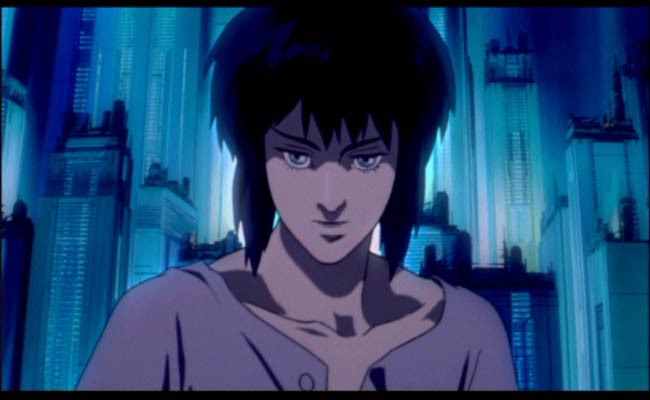
Revolutionizing Anime: Oshii revolutionized animation in GITS with a myriad of new and innovative computer graphics techniques. In short, Oshii pushed the boundaries for state-of-the art animation with GITS. Oshi scanned his animation cells in to a digital system so that he could import them into an editing suite to get all sorts of cool lens effects. For instance, in the above pic, Oshii is able to emulate a contra-pull type effect where the camera moves back, and the lens moves forward. In viewing this, the background expands while the foreground eerily stays in the same place. This works wonderfully for Motoko’s questioning of humanity speech. And this is only one of many interesting used of digital shots. Other techniques include interesting overlays that depict either brain activity or maps, for instance.
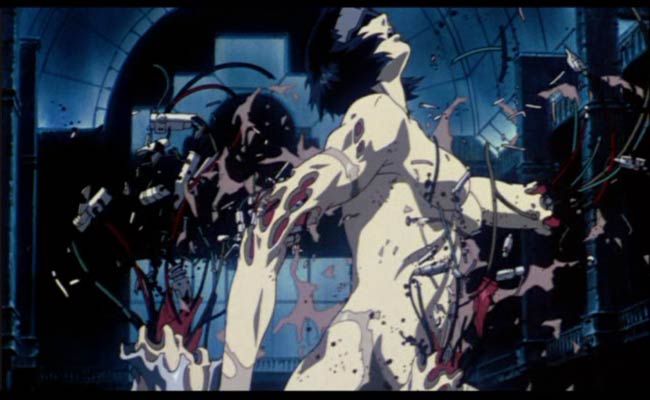
Questioning Humanity: Ghost in the Shell still provides anime’s the best examination in the questioning humanity. GITS is dominated by an ongoing discussion of what it means to be human and really, what it means to be alive. Is Motoko really still human? Even she doesn’t know the answer anymore, and actually questions whether she really has a ghost (how would she be able to differentiate a fake ghost from a real one?). This line of questioning is artfully developed in a way that makes Motoko the character in all of anime that I empathize with the most. You truly feel for the dilemma she finds herself facing.
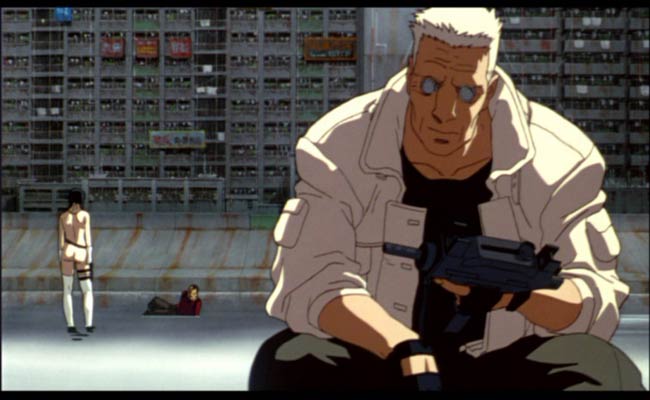
What is the Matrix? If we examine the Matrix, we find that both the visuals and storyline are heavily influenced by Ghost. There are some rather explicit visual “nods” in the first Matrix, including the opening digital sequence, Mr. Smith’s building jump where he breaks the concrete beneath him (this is virtually identical to Motoko pursuing the first puppet victim), and the shooting of the fruit stand where Neo is running near the end. On top of this, we have a reversal of roles in the Matrix, where Neo plays Motoko and Trinity emulates Batau. And again, the Wachowskis make no bones about where their influence came from - they, as much as anyone, have contributed to Ghost’s ever increasing popularity.
In looking at the storyline, we find even more interesting parallels. Ghost in the Shell ends with Motoko merging with the sentient program called the Puppet Master (Project 2501). This allows the Puppet Master produce a diversity of offspring that is simply not possible to do with copies alone. This has a direct parallel to the scifi view of Neo in the above review. While Ghost in the Shell 2: Innocence is the philosophical sequel to Avalon, the Matrix trilogy is just as clearly the sequel to Ghost in the Shell. Whereas GITS ends with this merging of a sentient program with a human ghost, the Matrix expands on this idea. We see Neo take the same journey, but in a very different way. He conducts this symbiotic merging over 3 movies whereas Motoko does this in a matter of minutes. We see Neo, through this merging of sentient program with a human, become the “one” - an omnipotent style being. This characterization is similar to the characterization that Batau gives of Motoko in GITS2 in his dogs and gods versus flawed humans speech.
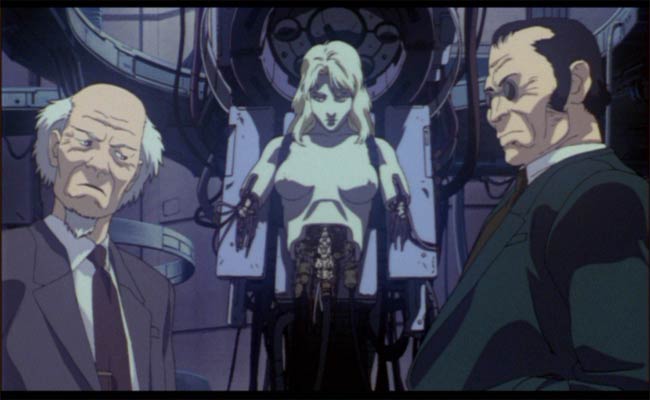
Also interesting is the linkage between the puppet master’s desire to digitally produce offspring with Neo’s reloading of the Matrix. The puppet master discusses this at the end of GITS in the “Life perpetuates itself through diversity and this includes the ability to sacrifice itself when necessary” monologue. If you trace the linkages, Neo’s reloading of the Matrix this is a method for the sentient program portion of Neo to create diversity and offspring. The merging of Neo allows the sentient program to grow and develop in ways simply not possible by itself. Familiarity with Neo’s Ghost allows it to make the changes necessary to correct the errors that build up in the current Matrix that prompt the battery people to disbelieve their surrounding.
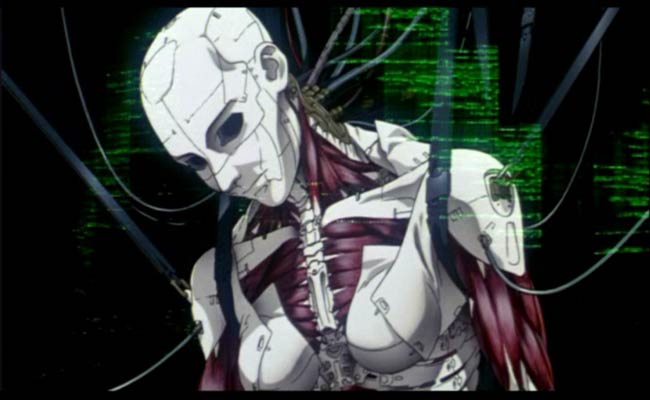
Finally, Ghost gives us a truly interesting vision of the future. We get sound astoundingly realistic and grungy cityscapes that are filled with the most impressive technological horrors. Is it truly a stretch to imagine that technology will augment our physical abilities? This is the bionic man taken to another level. On top of this, if we truly can learn to connect manufactured parts to our nervous system, is it really that far of a stretch to imagine that our brains become augmented? And over time, is it truly a stretch to believe that the line between humanity and robot won’t be blurred? GITS questions these articles of faith in such a believable way that we have seen a shift in our overall thinking on this issue.
The Bottom Line: Truly, even if you ignore all this philosophical stuff, Ghost in the Shell is simply an awesome movie! The action is terrific, the visuals are great, the soundtrack is devine…I could go on and on. If you just see one anime, Ghost in the Shell, still my favorite anime, is hands down the one to get.
Page 2: More GITS Screencaps –>>
~See movies similar to this one~
Tags: cyberpunk movie review anime ghost shell
|







































































